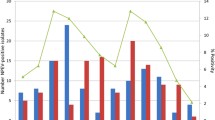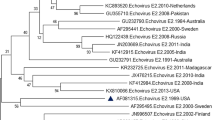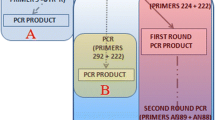Abstract
In Greece, data for human parechoviruses (HPeVs) are scarce and our aim was to conduct a large scale study to determine for the first time their occurrence. Under the spectrum of surveillance, we retrospectively screened stool specimens obtained from 71 children with acute flaccid paralysis (AFP) symptoms and from 311 individuals in high-risk population groups such as children living in bad sanitation conditions for HPeVs presence by rRT-PCR targeting the 5′ UTR. All positive samples were then genotyped by targeting the HPeVs VP1 region. Totally, 15/311 (5%) stool samples from children living in bad sanitation conditions and 4/71 (6%) from the non polio AFP children were positive for HPeVs. Sequencing analysis revealed that genotypes HPeV1 (n = 4/15), HPeV5 (n = 2/15), and HPeV6 (n = 2/15) were circulating among Roma children population whereas HPeV1 (n = 1/4) and HPeV5 (n = 1/4) were circulating in children with AFP-like symptoms. We did not obtain a seasonality motive among HPeV1 or HPeV5 genotypes whereas HPeV6 was detected only in July. Phylogenetic analysis showed that Greek HPeVs strains are clustered together with HPeV strains circulating in other European countries during the same period. We describe the presence of HPeVs in Greece, and we enforce that their diagnosis should be considered in children with neurological outcome such as non-polio AFP.



Similar content being viewed by others
References
Wildenbeest JG, Harvala H, Pajkrt D, Wolthers KC (2010) The need for treatment against human parechoviruses: how, why and when? Expert Rev Anti-Infect Ther 8:1417–1429
Cabrerizo M, Diaz-Cerio M, Munoz-Almagro C et al (2017) Molecular epidemiology of enterovirus and parechovirus infections according to patient age over a 4-year period in Spain. J Med Virol 89:435–442
Benschop KSM, Schinkel J, Luken ME et al (2006) Fourth human parechovirus serotype. Emerg Infect Dis 12:1572–1575
Olijve L, Jennings L, Walls T (2018) Human parechovirus: an increasingly recognized cause of sepsis-like illness in young infants. Clin Microbiol Rev 15(31):1
de Crom SCM, Rossen JWA, van Furth AM, Obihara CC (2016) Enterovirus and parechovirus infection in children: a brief overview. Eur J Pediatr 175:1023–1029
Figueroa JP, Ashley D, King D, Hull B (1989) An outbreak of acute flaccid paralysis in Jamaica associated with echovirus type-22. J Med Virol 29:315–319
AFP/polio data WHO, https://extranet.who.int/polis/public/CaseCount.aspx. Cited 08/01/2019 2019
Pogka V, Labropoulou S, Emmanouil M, Voulgari-Kokota A, Vernardaki A, Georgakopoulou T, Mentis AF (2017) Laboratory surveillance of polio and other enteroviruses in high-risk populations and environmental samples. Appl Environ Microbiol 15(83):5
Routsias JG, Mavrouli MD, Antonaki G, Spanakis N, Tsakris A (2014) Synthetic peptides for efficient discrimination of anti-enterovirus antibodies at the serotype level. Peptides 58:52–59
Spyridaki IS, Christodoulou I, de Beer L et al (2009) Comparison of four nasal sampling methods for the detection of viral pathogens by RT-PCR-A GA(2)LEN project. J Virol Methods 156:102–106
Nix WA, Maher K, Johansson ES, Niklasson B, Lindberg AM, Pallansch MA, Oberste MS (2008) Detection of all known parechoviruses by real-time PCR. J Clin Microbiol 46:2519–2524
Nix WA, Maher K, Pallansch MA, Oberste MS (2010) Parechovirus typing in clinical specimens by nested or semi-nested PCR coupled with sequencing. J Clin Virol 48:202–207
Tang JW, Holmes CW, Elsanousi FA, et al. (2016) Cluster of human parechovirus infections as the predominant cause of sepsis in neonates and infants, Leicester, United Kingdom, 8 May to 2 August 2016. Eurosurveillance 21:2–5
Fischer TK, Midgley S, Dalgaard C, Nielsen AY (2014) Human Parechovirus infection, Denmark. Emerg Infect Dis 20:83–87
Khetsuriani N, Lamonte-Fowlkes A, Oberst S, Pallansch MA (2006) Enterovirus surveillance--United States, 1970-2005. MMWR Surveill Summ 55:1–20
Abe M, Ueki Y, Miura T, Kimura S, Suzuki Y, Sugawara N, Masago Y, Omura T, Watanabe S (2016) Detection of human parechoviruses in clinical and municipal wastewater samples in Miyagi, Japan, in 2012-2014. Jpn J Infect Dis 69:414–417
van der Sanden SM, Koopmans MP, van der Avoort HG (2013) Detection of human enteroviruses and parechoviruses as part of the national enterovirus surveillance in the Netherlands, 1996-2011. Eur J Clin Microbiol Infect Dis 32:1525–1531
Ito M, Yamashita T, Tsuzuki H, Takeda N, Sakae K (2004) Isolation and identification of a novel human parechovirus. J Gen Virol 85:391–398
Watanabe K, Oie M, Higuchi M, Nishikawa M, Fujii M (2007) Isolation and characterization of novel human parechovirus from clinical samples. Emerg Infect Dis 13:889–895
Benschop KSM, Schinkel J, Minnaar RP et al (2006) Human parechovirus infections in Dutch children and the association between serotype and disease severity. Clin Infect Dis 42:204–210
Shah G, Robinson JL (2014) The particulars on parechovirus. Can J Infect Dis Med Microbiol 25:186–188
Kolehmainen P, Oikarinen S, Koskiniemi M, Simell O, Ilonen J, Knip M, Hyoty H, Tauriainen S (2012) Human parechoviruses are frequently detected in stool of healthy Finnish children. J Clin Virol 54:156–161
Tapia G, Cinek O, Witso E, Kulich M, Rasmussen T, Grinde B, Ronningen KS (2008) Longitudinal observation of parechovirus in stool samples from Norwegian infants. J Med Virol 80:1835–1842
Morikawa S, Hiroi S, Kase T (2015) Detection of respiratory viruses in gargle specimens of healthy children. J Clin Virol 64:59–63
Janes VA, Minnaar R, Koen G, van Eijk H, Haan KD, Pajkrt D, Wolthers KC, Benschop KS (2014) Presence of human non-polio enterovirus and parechovirus genotypes in an Amsterdam hospital in 2007 to 2011 compared to national and international published surveillance data: a comprehensive review. Eurosurveillance 19:15–23
Aizawa Y, Yamanaka T, Watanabe K, Oishi T, Saitoh A (2015) Asymptomatic children might transmit human parechovirus type 3 to neonates and young infants. J Clin Virol 70:105–108
van der Sanden S, de Bruin E, Vennema H, Swanink C, Koopmans M, van der Avoort H (2008) Prevalence of human parechovirus in the Netherlands in 2000 to 2007. J Clin Microbiol 46:2884–2889
Acknowledgements
None.
Author information
Authors and Affiliations
Corresponding author
Ethics declarations
Ethics policy
This study was approved by the institutional ethics committee of the Hellenic Centre for Disease Control & Prevention (HCDCP). Patient records were coded prior to analysis and no identifying details are included.
Conflict of interest
The authors declare that they have no conflict of interest.
Ethical approval
Not necessary.
Informed consent
Not necessary.
Additional information
Publisher’s note
Springer Nature remains neutral with regard to jurisdictional claims in published maps and institutional affiliations.
Rights and permissions
About this article
Cite this article
Ioulia, K., Vasiliki, P., Stavroula, L. et al. A 5-year study of human parechoviruses in children living in bad sanitation conditions and non-polio acute flaccid paralysis children from Greece. Eur J Clin Microbiol Infect Dis 38, 1907–1913 (2019). https://doi.org/10.1007/s10096-019-03627-7
Received:
Accepted:
Published:
Issue Date:
DOI: https://doi.org/10.1007/s10096-019-03627-7




